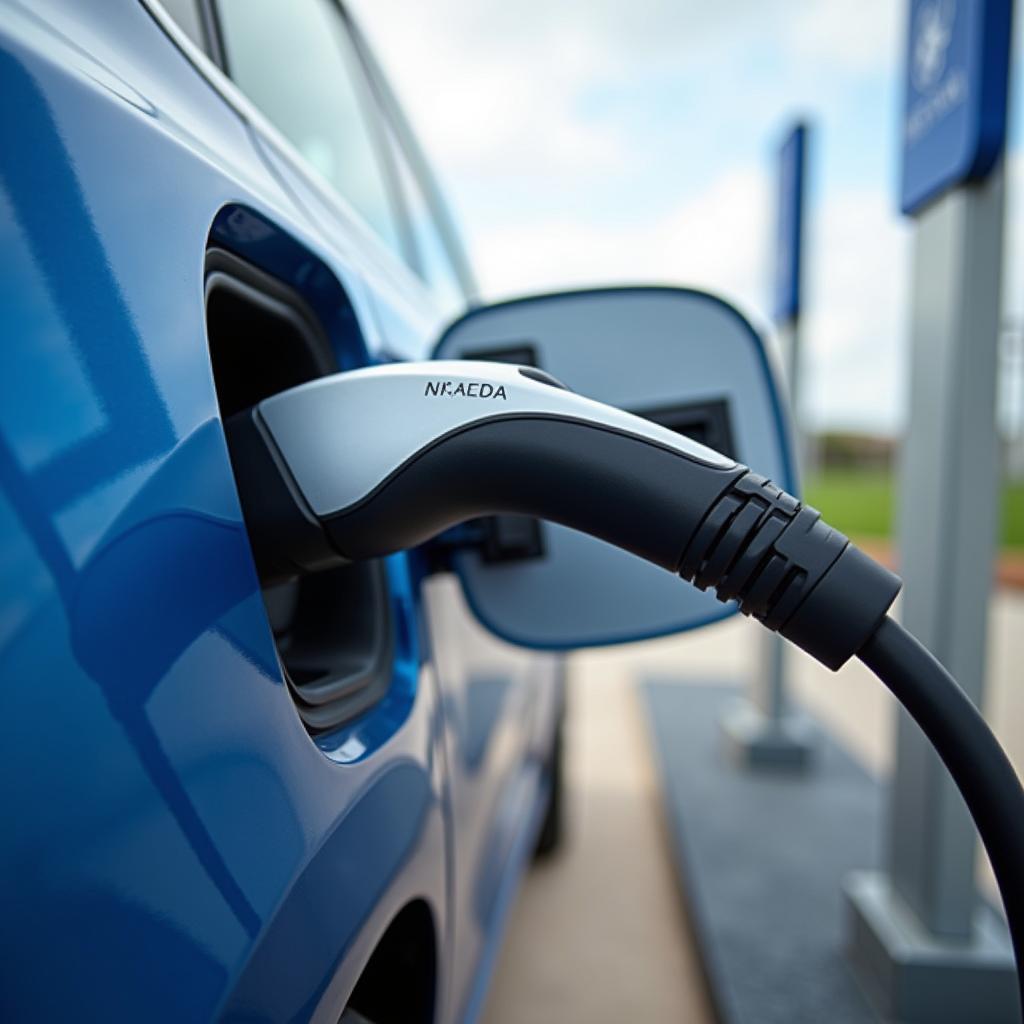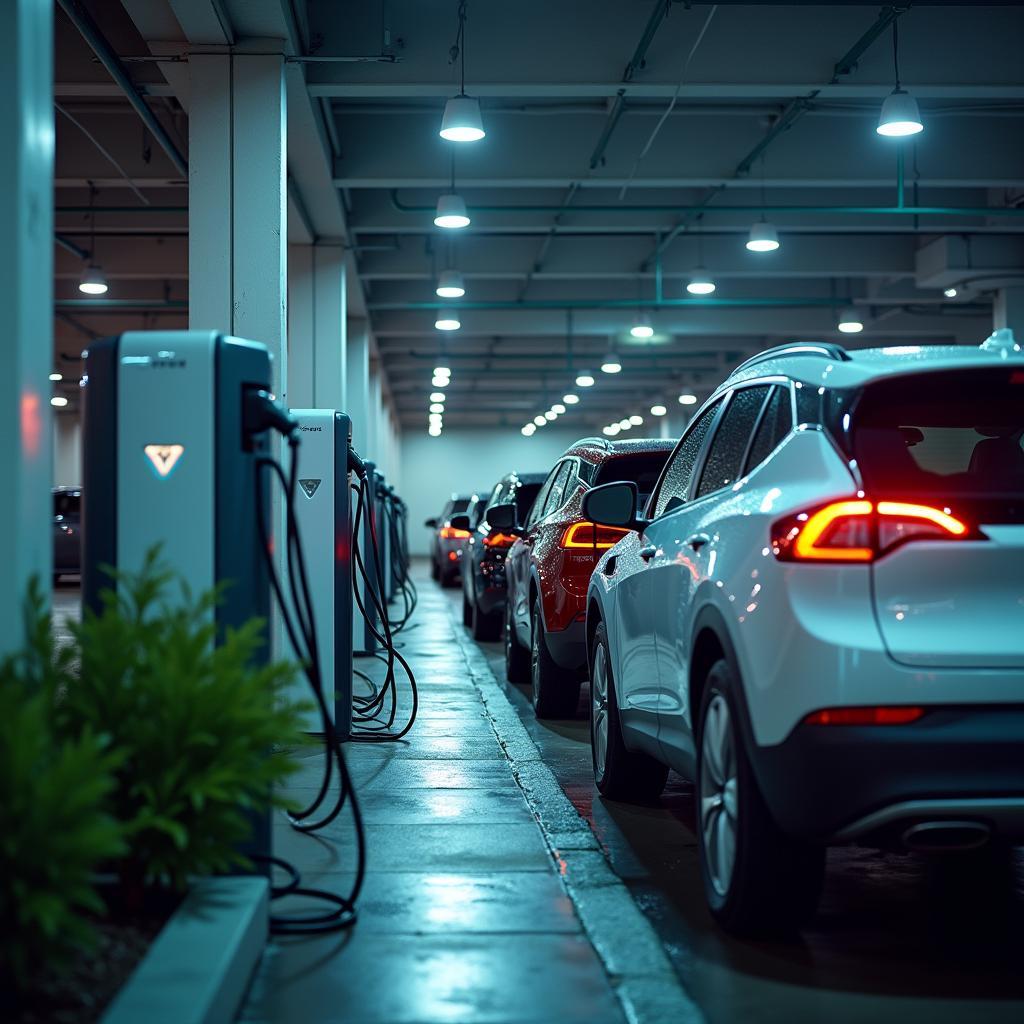Welcome to our IELTS Reading practice test focused on the crucial topic of “The role of electric vehicles in reducing air pollution.” This comprehensive test will help you improve your reading skills while exploring an important environmental issue. Let’s dive into the world of electric vehicles and their impact on air quality!
Introduction
Air pollution is a significant global concern, and the transportation sector is a major contributor to this problem. Electric vehicles (EVs) have emerged as a promising solution to reduce emissions and improve air quality in urban areas. This IELTS Reading practice test will examine various aspects of electric vehicles and their role in combating air pollution.
IELTS Reading Test Structure
This practice test follows the standard IELTS Reading test format, consisting of three passages of increasing difficulty:
- Passage 1 (Easy Text): An introduction to electric vehicles and their basic environmental benefits
- Passage 2 (Medium Text): The impact of electric vehicles on urban air quality
- Passage 3 (Hard Text): Government policies and future prospects for electric vehicles in reducing air pollution
Each passage is followed by a set of questions designed to test your comprehension and analytical skills. Let’s begin with the first passage!
Passage 1: Introduction to Electric Vehicles
Electric vehicles have gained significant attention in recent years as a potential solution to reduce air pollution and combat climate change. Unlike conventional vehicles that run on fossil fuels, electric vehicles are powered by rechargeable batteries, producing zero direct emissions during operation. This fundamental difference makes EVs an attractive option for environmentally conscious consumers and policymakers alike.
The history of electric vehicles dates back to the 19th century, but it wasn’t until the late 20th and early 21st centuries that they began to gain widespread popularity. Advancements in battery technology, particularly the development of lithium-ion batteries, have played a crucial role in making electric vehicles more practical and efficient.
One of the primary advantages of electric vehicles is their potential to significantly reduce air pollution in urban areas. Traditional gasoline and diesel-powered vehicles emit various pollutants, including carbon dioxide (CO2), nitrogen oxides (NOx), and particulate matter. These emissions contribute to poor air quality, which can lead to respiratory problems and other health issues for city residents.
Electric vehicles, on the other hand, produce zero tailpipe emissions. While it’s important to note that the overall environmental impact of EVs depends on the source of electricity used to charge them, studies have shown that even when powered by electricity from fossil fuel plants, electric vehicles generally have a lower carbon footprint compared to their conventional counterparts.
Moreover, as countries increasingly shift towards renewable energy sources such as solar and wind power, the environmental benefits of electric vehicles are expected to grow even further. This transition to cleaner energy sources will help maximize the potential of EVs in reducing air pollution and mitigating climate change.
 Modern electric vehicle at charging station, symbolizing renewable energy transition for cleaner air.
Modern electric vehicle at charging station, symbolizing renewable energy transition for cleaner air.
Questions 1-5: Multiple Choice
Choose the correct letter, A, B, C, or D.
- What is the main power source for electric vehicles?
A) Fossil fuels
B) Solar panels
C) Rechargeable batteries
D) Hydrogen fuel cells - When did electric vehicles begin to gain widespread popularity?
A) In the 19th century
B) In the mid-20th century
C) In the late 20th and early 21st centuries
D) Only in the last decade - Which technological advancement has played a crucial role in making electric vehicles more practical?
A) Improvements in solar panel efficiency
B) Development of lithium-ion batteries
C) Advancements in hydrogen fuel cell technology
D) Innovations in fossil fuel refining - What is one of the primary advantages of electric vehicles in urban areas?
A) Increased speed and performance
B) Lower purchase costs
C) Reduced air pollution
D) Improved fuel efficiency - According to the passage, how does the source of electricity affect the environmental impact of electric vehicles?
A) It has no impact on their environmental benefits
B) It determines whether EVs are more or less polluting than conventional vehicles
C) It only affects the charging speed of EVs
D) It influences the overall carbon footprint of EVs
Questions 6-10: True/False/Not Given
Do the following statements agree with the information given in the passage? Write:
TRUE if the statement agrees with the information
FALSE if the statement contradicts the information
NOT GIVEN if there is no information on this
- Electric vehicles produce zero emissions during operation.
- The first electric vehicle was invented in the 21st century.
- Conventional vehicles emit carbon dioxide, nitrogen oxides, and particulate matter.
- Electric vehicles always have a lower carbon footprint than conventional vehicles, regardless of the electricity source.
- The transition to renewable energy sources will enhance the environmental benefits of electric vehicles.
Passage 2: The Impact of Electric Vehicles on Urban Air Quality
The adoption of electric vehicles in urban areas has the potential to significantly improve air quality and public health. As cities around the world grapple with the challenges of air pollution, many are turning to electric vehicles as a key component of their environmental strategies.
One of the most immediate benefits of electric vehicles in urban settings is the reduction of localized air pollutants. Traditional internal combustion engines emit a range of harmful substances, including nitrogen oxides (NOx), particulate matter (PM), and volatile organic compounds (VOCs). These pollutants are known to cause or exacerbate respiratory problems, cardiovascular diseases, and other health issues. By contrast, electric vehicles produce zero tailpipe emissions, effectively eliminating these harmful pollutants at the point of use.
A study conducted in several major European cities found that widespread adoption of electric vehicles could lead to a significant decrease in nitrogen dioxide levels, with reductions of up to 10% in some areas. This improvement in air quality could have substantial health benefits for urban populations, potentially reducing the incidence of respiratory diseases and premature deaths associated with air pollution.
Moreover, the impact of electric vehicles on urban air quality extends beyond just the reduction of tailpipe emissions. The regenerative braking systems used in many electric vehicles help to reduce brake wear, which is a significant source of particulate matter in urban environments. Traditional vehicles release fine particles from their brake pads and rotors during braking, contributing to air pollution. Electric vehicles, with their ability to recapture energy during deceleration, reduce the need for mechanical braking and consequently lower the emission of these harmful particles.
Another often overlooked benefit of electric vehicles in urban settings is the reduction of noise pollution. Electric motors are significantly quieter than internal combustion engines, particularly at low speeds typical of city driving. This reduction in noise can contribute to improved quality of life for city residents and potentially reduce stress-related health issues associated with chronic exposure to traffic noise.
However, it’s important to note that the full environmental benefits of electric vehicles in urban areas depend on several factors. The source of electricity used to charge these vehicles plays a crucial role in determining their overall environmental impact. Cities that rely heavily on coal or other fossil fuels for electricity generation may see less dramatic improvements in air quality compared to those with cleaner energy grids.
Additionally, the life cycle emissions of electric vehicles, including the production and disposal of batteries, need to be considered for a comprehensive assessment of their environmental impact. While studies have shown that electric vehicles generally have lower lifetime emissions than conventional vehicles, continued improvements in battery technology and recycling processes are necessary to further enhance their environmental credentials.
Despite these considerations, the potential of electric vehicles to improve urban air quality is significant. As cities continue to invest in charging infrastructure and implement policies to encourage EV adoption, the positive impact on air quality is expected to grow. This transition not only addresses immediate air quality concerns but also aligns with broader goals of reducing greenhouse gas emissions and combating climate change.
Questions 11-15: Matching Headings
Match the following headings to the correct paragraphs in the passage. Write the correct number (i-viii) next to questions 11-15.
i. The role of energy sources in EV environmental impact
ii. Reduction of brake-related particulate matter
iii. Immediate benefits of EVs in urban areas
iv. The challenge of battery production and disposal
v. Noise reduction as an additional benefit
vi. Study findings on nitrogen dioxide reduction
vii. The importance of comprehensive environmental assessment
viii. Future prospects for EVs in urban settings
- Paragraph 2: _____
- Paragraph 3: _____
- Paragraph 4: _____
- Paragraph 5: _____
- Paragraph 8: _____
Questions 16-20: Summary Completion
Complete the summary below using NO MORE THAN TWO WORDS from the passage for each answer.
Electric vehicles offer several benefits for urban air quality. They eliminate (16) _____ emissions, reducing harmful pollutants such as nitrogen oxides and particulate matter. A study in European cities showed that EVs could lead to a (17) _____ in nitrogen dioxide levels. Additionally, the (18) _____ systems in EVs help reduce brake wear, further decreasing particulate matter in the air. EVs also contribute to a reduction in (19) _____, particularly at low speeds common in city driving. However, the full environmental impact of EVs depends on factors such as the (20) _____ used to charge them and the emissions associated with battery production and disposal.
Passage 3: Government Policies and Future Prospects for Electric Vehicles in Reducing Air Pollution
The role of electric vehicles in reducing air pollution has become a focal point for governments worldwide as they seek to address the pressing issues of climate change and urban air quality. Policy interventions and technological advancements are shaping the future of transportation, with electric vehicles at the forefront of this transformation.
Many governments have implemented a range of policies to encourage the adoption of electric vehicles. These policies typically fall into three categories: financial incentives, regulatory measures, and infrastructure development. Financial incentives often include purchase subsidies, tax credits, and reduced registration fees for electric vehicles. For example, Norway, a global leader in EV adoption, offers significant tax exemptions for electric vehicles, making them price-competitive with conventional vehicles.
Regulatory measures have also played a crucial role in promoting electric vehicles. Several countries and regions have announced plans to phase out the sale of new gasoline and diesel vehicles within the next few decades. The United Kingdom, for instance, has set a target to end the sale of new petrol and diesel cars by 2030, with hybrid vehicles following in 2035. Such ambitious targets send a clear signal to both consumers and manufacturers about the direction of the automotive industry.
Infrastructure development is another critical aspect of government policies supporting electric vehicles. The availability of charging stations is a key factor in consumer adoption of EVs, and many governments are investing heavily in expanding charging networks. China, the world’s largest EV market, has been particularly aggressive in building charging infrastructure, with plans to have 4.8 million charging stations by 2020.
The future prospects for electric vehicles in reducing air pollution are promising, driven by ongoing technological advancements and increasing consumer acceptance. Battery technology continues to improve, with researchers working on developing more efficient, longer-lasting, and environmentally friendly batteries. Solid-state batteries, for example, offer the potential for greater energy density and faster charging times, which could address some of the current limitations of electric vehicles.
Moreover, the integration of electric vehicles with smart grid technologies and renewable energy sources presents exciting possibilities for further reducing the environmental impact of transportation. Vehicle-to-grid (V2G) systems, which allow electric vehicles to feed energy back into the power grid during peak demand periods, could help balance electricity loads and support the integration of intermittent renewable energy sources.
 Urban EV charging hub with multiple vehicles, showcasing advanced infrastructure and smart grid technology.
Urban EV charging hub with multiple vehicles, showcasing advanced infrastructure and smart grid technology.
The potential impact of widespread electric vehicle adoption on air quality is significant. A study by the International Council on Clean Transportation (ICCT) found that a transition to 100% zero-emission vehicles by 2040 in major markets could reduce tank-to-wheel CO2 emissions from cars by 85% in 2050, compared to a baseline scenario. This reduction in emissions would have substantial benefits for both air quality and climate change mitigation.
However, challenges remain in realizing the full potential of electric vehicles in reducing air pollution. The environmental impact of battery production and disposal needs to be addressed through improved manufacturing processes and recycling technologies. Additionally, the transition to electric vehicles must be accompanied by a shift towards cleaner electricity generation to maximize their environmental benefits.
Furthermore, the equity implications of the transition to electric vehicles need to be considered. Policies should ensure that the benefits of improved air quality are distributed fairly across society, and that low-income communities are not left behind in the transition to cleaner transportation.
In conclusion, while electric vehicles offer significant potential for reducing air pollution, realizing this potential will require continued technological innovation, supportive government policies, and careful consideration of broader environmental and social impacts. As the world moves towards a more sustainable transportation future, electric vehicles are poised to play a crucial role in improving air quality and combating climate change.
Questions 21-25: Matching Information
Match the following statements (A-H) with the correct paragraph (21-25) in the passage. Write the correct letter A-H next to questions 21-25.
A) The importance of charging infrastructure in promoting EV adoption
B) The potential of new battery technologies to overcome current EV limitations
C) The need for equitable distribution of air quality benefits from EV adoption
D) The role of financial incentives in encouraging EV purchases
E) The integration of EVs with renewable energy and smart grid systems
F) The impact of regulatory measures on the automotive industry
G) The challenges of addressing the environmental impact of battery production
H) The potential reduction in CO2 emissions from widespread EV adoption
- Paragraph 3: _____
- Paragraph 4: _____
- Paragraph 5: _____
- Paragraph 6: _____
- Paragraph 7: _____
Questions 26-30: Sentence Completion
Complete the sentences below using NO MORE THAN THREE WORDS from the passage for each answer.
- Government policies to promote electric vehicles typically fall into three categories: financial incentives, regulatory measures, and _____.
- Norway offers significant _____ for electric vehicles to make them competitive with conventional vehicles.
- The United Kingdom plans to end the sale of new petrol and diesel cars by _____.
- Vehicle-to-grid systems allow electric vehicles to _____ during peak demand periods.
- The transition to electric vehicles must be accompanied by a shift towards _____ to maximize their environmental benefits.
Answer Key
Passage 1:
- C
- C
- B
- C
- D
- TRUE
- FALSE
- TRUE
- FALSE
- TRUE
Passage 2:
- iii
- vi
- ii
- v
- viii
- tailpipe
- significant decrease
- regenerative braking
- noise pollution
- source of electricity
Passage 3:
- F
- A
- B
- E
- H
- infrastructure development
- tax exemptions
- 2030
- feed energy back
- cleaner electricity generation
Congratulations on completing this IELTS Reading practice test on “The role of electric vehicles in reducing air pollution”! We hope this exercise has not only improved your reading skills but also deepened your understanding of this important environmental topic. Remember to review your answers and analyze any mistakes to further enhance your performance.
For more IELTS practice and insights into environmental topics, check out our related articles on how smart cities are reducing urban pollution and the impact of electric aviation on global air travel. These resources will help you broaden your knowledge and prepare for your IELTS exam.
Keep practicing and stay informed about current environmental issues. Good luck with your IELTS preparation!


